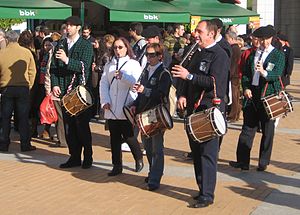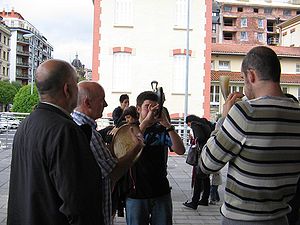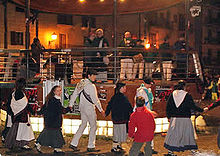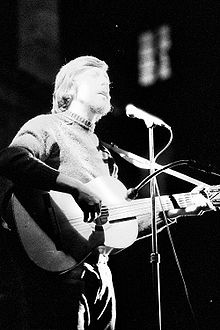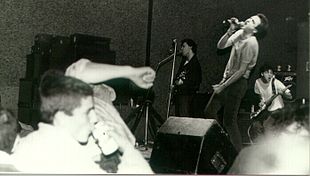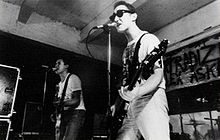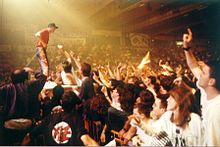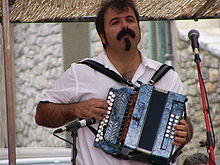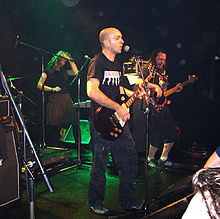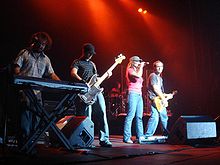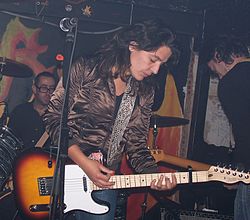- Basque music
-
The strict classification of Basque music remains a controversial issue, complicated in part by the growing diversification of such music, but by and large it is made in the Basque Country, it reflects traits related to that society/tradition and it is devised by people from the Basque Country.
Contents
Traditional music
Basque traditional music is a product of the region's historic development and its geographical location between the Cantabrian mountain range, the Ebro river and the Pyrenees. Because this area is open to the wider world, for example through international pilgrimage on the Way of St James, many feel that it should not be considered as having evolved in isolation.
Instruments
Folk instruments widespread in Europe ceased to be used in some places at some point of history and only remained in specific areas, where they took hold and adopted features and a character associated with the region, e.g. the three-hole pipe or tabor pipe in widespread use in Europe ultimately resulted in two specific instruments in the Basque Country: the txistu and the xirula. Accordingly, different instruments may have evolved out of one, such as Navarrese dulzaina and Souletin txanbela, with slight differences between them.[1]
Most of the instruments that have been taken up in rural and folk circles do not go back more than six centuries, some having been introduced as late as the 19th century, such as trikitixa or txistu, as we know it today (at any rate, the latter results from a long evolution). Most Basque instruments originated outside the Basque Country and became popular in the territory at some stage (but the txalaparta is not one of these).
Some traditional Basque instruments are the following:
- Alboka, a difficult double clarinet played in a circular breathing technique similar to that used for the Sardinian launeddas.
- Txalaparta, a wooden xylophone-like percussion instrument for two players.
- Kirikoketa, a wooden percussion device akin to the txalaparta associated with the cider making process.
- Toberak, a percussion instrument made of horizontal metal bars.
- Txistu, a local pipe.
- Drum, called danbolin, and usually accompanying the txistu.
- Atabal, a double sided flat drum played together with aerophones.
- Xirula, a three-hole flute, shorter and more high-pitched than txistu.
- Ttun-ttun, a vertical stringed drum played usually together with the xirula.
- Trikitixa or eskusoinua, a lively diatonic button accordion.
- Tambourine, usually played together with the trikitixa.
- Dulzaina, a Navarre based pipe belonging to the shawm family.
- Blowing horn, an instrument made of ox horn.
Singing tradition
The Basque people are especially given to singing. Basque language has stuck to the oral tradition stronger than Romance languages, and its literature was first recorded in writing in the 16th century. There are ballads dating from the 15th century that have been passed from parents to children by word of mouth, e.g. Ozaze Jaurgainian from Soule, which relates events six centuries ago and has come down to us in different versions (the best known was popularized by Benito Lertxundi), or Alostorrea, from Biscay. These ballads were crafted and spread by minstrels or bertsolaris, were kept in popular memory, and were transmitted in the so-called kopla zaharrak, sets of poems with a characteristic rhythmic pattern that could be sung: this is similar to traditional practices elsewhere in Europe. So, for example, the first work of literature in Basque Linguæ Vasconum Primitiæ (1545) by Bernard Etxepare shows long verses that, while deceptively fashioned in metres resembling those used in Romance poetry, follow an internal rhythmic pattern similar to a kopla, so they can be popularly sung. Even today, it is not unusual to see groups of people marching around a town at some local festival singing and asking the neighbours for a food, drink or money donation, while the most famous celebrations following this pattern across the whole Basque Country may be those taking place on Christmas Eve (Olentzero) and the Saint Agatha's Eve, with singers dressing up in traditional costumes.
It follows that traditional singing is closely related to bertsolaris, improvising bards, who even nowadays hold an important status in Basque culture. They voice the people's concerns by means of a formal tradition coming from the people (tunes, linguistic devices), and act as their spokespersons. A considerable corpus of traditional songs was gathered by Resurrección María de Azkue and Aita Donostia, two religious scholars interested in Basque folk culture, at the turn of the 20th century; and also later on, in Cancionero popular vasco (1918) and Euskal Eres-Sorta. Cancionero Vasco (1922), to mention but a few works. In the present day, the band Hiru Truku (comprising the celebrated musicians Joseba Tapia, Ruper Ordorika and Bixente Martinez) has chosen several ancient songs from all over the Basque Country, updated the music brilliantly and released them in a number of albums. Another current long-standing and renowned group who elaborate on traditional songs is Oskorri: The band set about singing traditional songs in public performances previously handing out to the audience a repertoire bill including the lyrics and encouraging them to sing along. The band has launched a couple of albums of this kind so far and performed on various tours to public acclaim, becoming especially popular with middle-aged parents.
A key figure bridging the old singing tradition of Soule and the folk song revival of the 20th century should be noted here, Pierre Bordazaharre (1907–1979), aka Etxahun Iruri. A xirula player and singer, he collected old songs and fashioned new ones, which eventually caught on and spread, take for instance, Agur Xiberoa. He also contributed to new pastoral plays in the tradition of Soule, reshaping the pastoral and adding new topics.
There is also a tradition of choral music all over the Basque Country. Church choirs were set up in some towns to meet the religious musical needs. Yet at the turn of the 20th century some ensembles became established outside the ecclesiastical context, e.g. the Sociedad Coral de Bilbao (founded in 1886), Orfeón Donostiarra (founded in 1897) or the Coral Santa Cecilia from Donostia (founded in 1928). Later on, other ensembles were formed, such as Oldarra Abesbatza from Biarritz (founded in 1947), made up of men and sometimes putting on performances as an ochote (see below),[2] or the reputed Coral Andra Mari from Errenteria, established in 1966, featuring Basque folk music and Aita Donostia's several scores.[3] Nowadays many minor choral ensembles, largely offering the Basque folk repertoire, dot the Basque territory. Interestingly, in Bayonne and Donostia a cheerful informal initiative has grown popular with amateurs in the late noughties, who meet once a month and go bar hopping around the streets of the respective Old Quarters while singing traditional songs.
Another Basque choral phenomenon is represented by the so-called ochotes, which became popular in the 1930s in the Bilbao region: Eight men with deep voices, with a marked taste for local and folk subjects, singing in Spanish and Basque. The may stem from summer ecclesiastic seminaries and they thrived on the warm atmosphere of the bars after the work shift was over).[4] Eventually a branch of this genre evolved out into bilbainadas (up to the 1960s, nowadays much in decay).
Composers
The Basque Country has been home to various notable composers, writing mainly in the 20th century. Much in step with the artistic trends of the first half of the century (painting,...), some of them developed a liking for Basque customs, manners and subjects.
- Juan de Anchieta (1462–1523): Composer of the Renaissance hailing from the area of Azpeitia.
- Santiago de Herdoiza (Durango, c. 1700)
- Juan Crisostomo Arriaga (Bilbao, 1806 - Paris, 1826)
- Jose Maria Usandizaga (Donostia/San Sebastian, 1887–1915): He is considered along with J. Guridi the father of Basque opera. He drew up orchestral and chamber pieces, like the celebrated Cuarteto de cuerda en Sol, Op. 31, shifting to elaborate zarzuela as well as opera works at the end of his life (Mendi-Mendiyan, 1910: Las Golondrinas, 1914). He had his increasingly successful career cut short by an early death.
- Jesus Guridi (Vitoria-Gasteiz, 1881 - Madrid, 1961): Himself a friend of Usandizaga, whom he met in Paris while attending the Schola Cantorum, he was appointed manager of Bilbao's Sociedad Coral choir in 1912. Influenced by Wagner and musicians of the Late Romanticism, he found inspiration and phrases for his compositions in Basque folklore. His rich musical education enabled him to deal with different types of music, e.g. zarzuela, opera, compositions for choir as well as religious pieces for organ. Some acclaimed works include El caserío (1926), Diez melodías vascas (1940), La meiga (1929), Seis canciones castellanas (1939) and Sinfonía pirenaica (1945).
- Nemesio Otaño (Azkoitia, 1880 - San Sebastian, 1956 ): Composer, organist and musicologist. One of the most important figures in 20th century Spanish music history. Director of the Royal Conservatory of Madrid between 1939 and 1956. Among his most known works is 'Saint Ignatius March' ('Marcha de San Ignacio'), the saint patron of Biscay and Guipuscoa. In 1894 studied in the Colegio Preceptoría de Baliarrain, in which he composed two of his first Letanías and a Zortziko for piano; he was then only fourteen years old, but already played the organ in the school Parish. In 1896 he joined the Society of Jesus and began his ecclesiastical studies along with the music classes. In 1911 he founded the Schola Cantorum at Comillas: His performances in plainsong and polyphony were highly influential. His works range from popular sacred songs (e.g. Estrella hermosa, Anima Christi, Baldako) to large-scale choral pieces.
- Pablo Sorozabal (Donostia/San Sebastian, 1897 - Madrid, 1988)
- Maurice Ravel (Ziburu, 1875 - Paris, 1937): Basque born French composer and arranger.
- Carmelo Bernaola (Otxandio, 1929 - Madrid, 2002)
- Francisco Escudero (Donostia/San Sebastian, 1912–2002), composer of Zigor and Gernika), operas with Basque librettos
- Sebastian Iradier (Lanciego, 1809 - Vitoria-Gasteiz, 1865)
Basque musical revival
In the wake of the Civil War (1936-1937 in the Basque territory), headway made in the Basque culture in the pre-war period ground to a halt: Fear grew amidst harsh repression, famine became an overriding concern, and former cultural figures died or ran for their lives to exile. As an individual singing figure of the 40s, 50s and 60s, Luis Mariano and his powerful tenor voice should be highlighted. Born in Irun and moving in his 20s to Bordeaux, he jumped onto the Spanish and international scene with lighthearted songs in Spanish and French (and, occasionally, in Basque). After the hardest post-war years had gone by, the younger generation set about putting together duos and small musical groups in Gipuzkoa and Biscay, who gradually began singing original tunes in Basque. Notable bands from the 60s include Urretxindorrak, Enarak, Soroak and Estitxu (female singer born to fleeing parents near Bayonne). These new bands sought to take advantage of the regime's increasing liberalization, despite the fact that major obstacles that still hindered cultural activity associated with anything Basque. Cultural and political awareness, social rebelliousness and an urge for action cropped up in succeeding generations, resulting in a new left-leaning Basque nationalist movement.
Some people from the southern Basque Country fled the territory to the Northern Basque Country and sought refuge. They left their imprint in the traditional Basque society from the Northern Basque Country, contributing to giving rise to cultural and political awareness. In this respect, Mixel Labeguerie should be noted, who worked and lived in Kanbo, its mayor for more than a decade (1965–1980), Councillor General of the department and a founder of Basque nationalist movement Enbata (he walked out later). He had a musical education, soaked up the new European musical trends, e.g. Brassens, folk music from England and France, and released an album in 1961 with songs that struck a chord, such as Gu gira Euskadiko, Primaderako liliak, etc.[5] He was to have influence on the new artistic Basque group "Ez dok amairu" put together in 1965, largely made up of folk singer-songwriters concerned with Basque culture: Benito Lertxundi, Mikel Laboa (popular song "Txoriak txori"), Xabier Lete, Lourdes Iriondo, etc. Lourdes Iriondo took to singing accompanied on a guitar for the first time in Basque music, a fact that came in for much criticism on the grounds that the instrument was alien to the own culture. "Ez dok amairu" broke up in 1972 and its members took up separate paths that eventually have confirmed some of them as acclaimed and key folk Basque singers up to the 2000s. Along the lines of singer-songwriter style, in a context of social and political unrest, it is worth mentioning Guk, Larralde eta Etxamendi or the beloved duo Pantxoa eta Peio from the Northern Basque Country, who provide the musical background for the 70s period of struggle, repression and turmoil. Especially in the provinces of Álava and Navarre, Enrike Zelaia (Altsasu) and Gorka Knörr struck a chord with a more folkloric and nuanced approach.
Meanwhile, new and more urban style musical ensembles and bands sprang up in the 70s, performing first to other's songs of the time at summer local festivities. Yet they gradually developed their own repertoire fashioned in line with the Basque revival and activism (special focus on the lyrics) and ongoing Western musical trends, e.g. folk (Gwendal for one), progressive rock (Pink Floyd,...). As regards choral bands, Mocedades from Bilbao should be highlighted, founded in 1967 initially by Amaya Uranga and two sisters of her. They soon gained public notability by ranking second at the 1973 Eurovision Song Contest. That very year in the same city the prolific Oskorri band (see above) got together featuring folk music, launching first album in 1976, where they paid homage to poet Gabriel Aresti, while in the Northern Basque Country Michel Ducau and Anje Duhalde teamed up and put together the first Basque rock band: The celebrated and politically engagé Errobi, releasing album Errobi (1975) to critic and public acclaim, Bizi bizian ensued. The group disbanded (not definitely) in 1979.
Beginning at the mid-60s, Imanol Larzabal led a solo career as a singer/songwriter, featuring a deep voice as well as a socially committed and poetic subjects, with the collaboration of domestic and foreign poets and singers. He went through a short period in prison and came back from exile in 1977. Friend of his and son of emigrant Souletin parents, Niko Etxart came back to the Basque Country from Paris with brand-new ideas about music in 1972, so turning into a forerunner of Basque rock music (Euskal Rock&Roll released in 1979) alongside the band Errobi, while especially in the traditional Northern Basque Country some lashed out at his looks, manners and music. He alternately performed onstage in "verbenas" (dancing music in local festivities) with the band Minxoriak up to the late 80s. In the area of Mutriku, Itoiz, a milestone in Basque folk-pop music, was formed in 1978, with Juan Carlos Perez as its lead vocalist and frontman, releasing that very year the critically acclaimed album Itoiz, which contained such poignant tracks as Hilzori, Lau teilatu etc. Akin ensemble Haizea delivered a couple of good LPs in this period.[6]
Up to that point, Basque music bands from the Southern Basque Country resorted to labels from Spain to record and release their works. Yet at the end of the 70s and notably early in the 80s new regional labels arose (Xoxoa, Soñua...), providing a springboard for small bands that previously found it difficult to see their works published. At the same time, a whole network of youth squats, the gaztetxes, sprang up all over the Basque Country, so furnishing small bands with premises to rehearse and a venue to stage concerts, in a way that a younger disaffected and unruly generation stemming from urban sprawls and towns could find an outlet to voice its protest along the lines of a punk outlook ("do it yourself"). 1984 is the year for the outbreak of punk rock or so-called Basque Radical Rock or Rock Radical Vasco in Spanish.
Some popular bands jumping into the rock scene of the time were Zarama and Eskorbuto from Santurtzi, rocky Barricada and whimsical Tijuana in Blue from Pamplona, La Polla Records from Agurain, Kortatu and Baldin Bada from Irun, Hertzainak, Cicatriz and Potato from Vitoria-Gasteiz, Jotakie, RIP, Naste Borraste, MCD, BAP, Zer Bizio, Delirium Tremens, etc. Most of the times Spanish language was used, sometimes Basque, while other times bands were bilingual. This new musical trend clashed with the previous singer-songwriter tradition (generation gap), so much so that both were linked to different degrees to the leftist and Basque nationalist movement. Meanwhile, Itoiz kept its low-profile musical path switching to pop in the accomplished album Musikaz blai (three more LP albums followed), featuring internationally acclaimed songs like To Alice, As Noites da Radio Lisboa or the catchy Marea gora.
Other bands of the late 80s stack to a different path, gentle and even naïve, using Spanish-language lyrics and along the lines of a pop tradition, take for instance, Duncan Dhu (with leading figure Mikel Erentxun), 21 Japonesas or Sanchis y Jocano, bands from the area of Donostia. Duncan Dhu especially attained big levels of popularity on the Spanish and international pop scene, giving rise to a tradition in ensuing years that was to be called "Donosti Sound" (Le Mans, La Oreja de Van Gogh,...).
Current popular music
In 1990, Basque-language public radio station Euskadi Gaztea was born, intending to target the youth in a young, dynamic and informal manner, besides adding information, dealing with subjects Basque young people may be interested in and encouraging Basque groups. Basque music definitely opened its mind to trends all over the world. The flagship Basque rock band Kortatu broke up in 1988 (live album Azken guda dantza), and soon after brothers Muguruza put together project Negu Gorriak. They showed a different outlook compared to previous band Kortatu: The new band sang entirely in Basque, their approach was more hedonistic and showed a taste for rap, an attitude displayed in a video clip (Radio Rahim) that conjures up American hip-hop manners. Punk style fell much in decay, while reggae as well as hardcore took over, e.g. Anestesia, Etsaiak, Sociedad Alkoholika, Su Ta Gar (heavy), etc. M-ak launched its best album Barkatu ama to critical acclaim, featuring styles ranging from hardcore to gentle tracks.
Early in the 90s, younger generations took up folk again, finding a public that was eager to listen to milder tunes in Basque, e.g. Sorotan Bele, Mikel Markez, etc. Trikitixa schools finally bore fruit in the 90s: The novelties brought about by Tapia eta Leturia and Kepa Junkera confirmed them as folk references in the Basque Country and abroad, following that novel trikitixa duos tried new ways, sometimes setting up bands by adding bass guitar and drums to the set pair of diatonic button accordion and tambourine, e.g. Maixa eta Ixiar, Alaitz eta Maider, Gozategi. They usually offered a cheerful repertoire, with Gozategi's song Nirekin ("Emoixtaxux muxutxuek...") hitting the summer charts in 2000 beyond language boundaries.
Rock band Hertzainak disbanded in 1993, while its members followed their own projects. Controversial singer Gari started up a solo and very personal career with some accomplished songs, while Josu Zabala collaborates with other singers and group projects of some bertsolaris, e.g. original brass band Karidadeko Benta (first album 2003). Power pop band Urtz, formed in 1988, dealt with personal stories that slightly differed from the still prevailing protest topics and harsh language of the late 80s, besides featuring an unprecedented chorus line that delivered some charming, upbeat and catchy songs. The band broke up in the early 2000s. In step with the hardcore tradition, the band Berri Txarrak from Lekunberri got together in 1994, releasing various albums (latest album Jaio. Musika. Hil -2005-) and touring on Europe, where they come in for good reviews and gradually get a reputation that earned them performances and collaborations with important figures of indie rock all over the world. The band PiLT (Mungia), who showed a taste for metal and hard sounds (Clawfinger, Soundgarden), jumped into spotlight in 1995 after winning the bootleg contest "Gaztea Sariak" granted by radio station Euskadi Gaztea, while the definite hit came in 1996 with single Hil da jainkoa, earning them widespread recognition.[7] Likewise heavy metal band Latzen came to public prominence after winning with the popular ballad Laztana the 1997 edition of the "Gaztea Sariak".
The bands Skalariak (1994) and Betagarri (1992) took over the ska tradition, offering boogie inciting and swinging live concerts. In step with other multicultural experiences, such as Fermin Muguruza from Negu Gorriak or festive Joxe Ripiau to highlight but a few, in 2003 members of Etsaiak put together Pin pan pun band, a band with good connections in Latin America, releasing in 2005 the DVD Kuba-Mexiko Rock Tour 04, which bore witness to their experience and live powerful concerts. Etsaiak joined together again in 2008 (launched album Apurtu arte).[8] The band hailing from Zarautz Delorean does electronic&rock with enthralling and trance raising live performances. Other rock bands on the rise in 2008: Surfing Kaos (Donostia), We Are Standard (Getxo), Kaotiko (Agurain), The Uskis (Elantxobe), Atom Rhumba (Bilbao), Ken 7 (Gernika), Capsula (Bilbao)...
Doctor Deseo was set up in Bilbao in 1986, releasing thereafter various albums during a period that spans more than 20 years. They deal with everyday and personal subjects in a rather poetic manner. Fito y los Fitipaldis (Bilbao) was formed in 1998 by Platero y Tú's frontman Fito Cabrales, comprising a variety of styles ranging soul, blues, swing, flamenco, tex-mex or Hawaiian guitars. The project kicked off with A puerta cerrada (40,000 albums sold so far) and grew steadily in popularity, one of the latest hit song being Rojitas las orejas.[9]
In Donostia, youths from university gathered together in the mid-90s to rehearse. Yet they were in need of a singer for the band, so they fixed up a casting meeting with Amaia Montero that resulted in the creation of La Oreja de Van Gogh, who after launching album Dile al sol took off boosted by Amaia's mighty voice and catchy soft tunes trimmed with beautiful arrangements. New hit songs and albums followed.
The singer-songwriter approach that waned in the late 80s shows presently a sound condition in the Basque scene, with some very outstanding figures, like poignant Anari, renowned for her intense, heartbreaking voice and songs, who is now taking off (live recording Anari Kafe Antzokian Zuzenean released in 2008). Other singer-songwriters include Petti, from Bera (Navarre), with four albums published up to 2008, or the bertsolari Mikel Urdangarin, featuring somewhat melancholic songs often accompanied on string and brass instruments. Following the folk and singer-songwriter tradition, Jabier Muguruza (born 1960) took up a solo career in 1994 after quitting other projects (Les Mecaniciens,...). He sets about composing and performing intimate, mild songs with strong broody and literary lyrics. Meanwhile, some renowned figures of Basque folk music have kept on performing and creating, e.g. Benito Lertxundi, Mikel Laboa (died in December 2008) or Oskorri (fresh album Banda band in 2007, about to celebrate the ensemble's 35 anniversary).
In the Northern Basque Country, the festive band Sustraia attained great popularity after 15 years on the road, while the death (January 2009) of charismatic frontman Patrick Mixelena, aka Mixu, made the group's future uncertain. The ensemble Bidaia, i.e. the couple Mixel Ducau and Caroline Phillips, offers gentle and elaborate folk music, while percussionist Benat Achiary (born 1947) provides an experimental approach, often featuring improvised passages in his performances (several albums released in the 90s). Amaia Zubiria (born 1947 in Zubieta -Gipuzkoa-), who has occasionally collaborated with him, holds a long and prolific career in the Basque song panorama: She came to the spotlight with progressive-folk group Haizea, having published some solo albums since and featuring a very pure mezzo-soprano voice. Her latest work is the album Nabil (2008).[10]
Samples
References
- ^ "Basque Instruments". Xarnege. http://www.xarnege.com/1024x768/english/indexeng.htm. Retrieved 2008-03-13.
- ^ "OLDARRA (Biarritz)". Euskadiko Zortzikote Elkartea. http://www.otxoteup.com/euskara/oldarra_4.htm. Retrieved 03/02/2008. Site in Basque and Spanish
- ^ "Coral Andra Mari Abesbatza". Coral Andra Mari Abesbatza. http://www.coralandramari.com/OrriaEraiki.php?HIZKUNTZA=eusk&SAILA=andramari. Retrieved 03/02/2008. Site in Basque and Spanish
- ^ "Historia del Ochote". Festival Internacional de Ochotes de Portugalete. http://www.festivaloctetosportugalete.com/paginas/03historia/historiaochote.html. Retrieved 03/02/2008. Site in Spanish
- ^ "Mixel Labeguerie (1921-1980)". Eusko Jaurlaritzaren Argitalpen Zerbitzu Nagusia. http://www1.euskadi.net/euskara_sustapena/bidegileak/datos/labeguer.pdf. Retrieved 05/02/2008. Site in Basque
- ^ "Basque Progressive Music". http://progressive.homestead.com/BASKPROG.html. Retrieved 05/02/2008.
- ^ "PiLT, Al Grano". MONDOSONORO. http://www.mondosonoro.com/detall_entrevista.asp?id=21545. Retrieved 07/03/2008. Site in Spanish
- ^ ""APURTU ARTE", ETSAIAK-EN ZORTZIGARREN DISKOA". ENTZUN. http://www.entzun.com/noticias_view.php?uuid=1699. Retrieved 07/02/2008. Site in Basque
- ^ "Fito y Fitipaldis". TodoMúsica. http://www.todomusica.org/fito_y_fitipaldis/. Retrieved 07/03/2008. Site in Spanish
- ^ "Amaia Zubiria". Producciones Serrano. http://www.pserrano.com/amaia/amaia.html. Retrieved 07/03/2008. Site in Spanish
Further reading
- Khteian-Keeton, Teddy (1994). Guide to Basque Music. Idaho Arts Archives & Research Center Filer P. ISBN 0-9675042-0-1.
- Martija, José Antonio Aran (1985). Basque Music. Basque Government. ISBN 84-7568-071-2.
External links
- Basque Music and Art (Buber's Basque Page)
- Free scores of Basque music in the Choral Public Domain Library (ChoralWiki)
- Badok, information on Basque music run by the daily newspaper Berria
Music of Basque regions General topics Regional music

